Related Research Articles
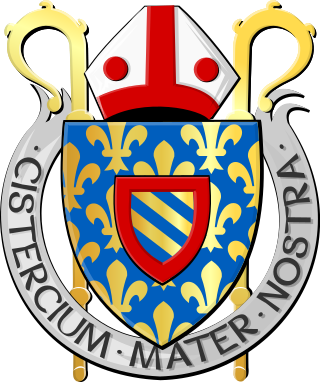
The Cistercians, officially the Order of Cistercians, are a Catholic religious order of monks and nuns that branched off from the Benedictines and follow the Rule of Saint Benedict, as well as the contributions of the highly-influential Bernard of Clairvaux, known as the Latin Rule. They are also known as Bernardines, after Saint Bernard himself, or as White Monks, in reference to the colour of the "cuculla" or cowl worn by the Cistercians over their habits, as opposed to the black cowl worn by Benedictines.
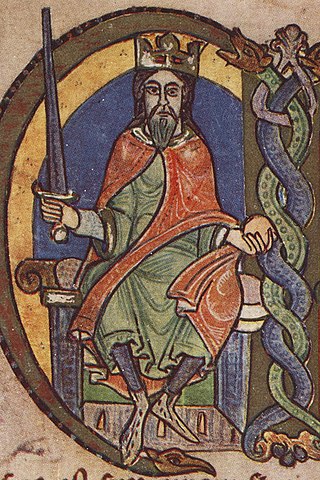
David I or Dauíd mac Maíl Choluim was a 12th century ruler and saint who was Prince of the Cumbrians from 1113 to 1124 and later King of Scotland from 1124 to 1153. The youngest son of King Malcolm III and Queen Margaret, David spent most of his childhood in Scotland but was exiled to England temporarily in 1093. Perhaps after 1100, he became a dependent at the court of King Henry I of England, by whom he was influenced.

The Battle of the Standard, sometimes called the Battle of Northallerton, took place on 22 August 1138 on Cowton Moor near Northallerton in Yorkshire, England. English forces under William of Aumale repelled a Scottish army led by King David I of Scotland.
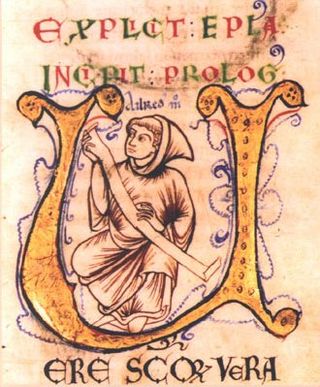
Aelred of Rievaulx, O Cist., also known as also Ailred, Ælred, or Æthelred; was an English Cistercian monk and writer who served as Abbot of Rievaulx from 1147 until his death. He is venerated by the Catholic Church as a saint and by some Anglicans.

This article presents lists of the literary events and publications in the 12th century.
Gilbert of Hoyland (11??–1172?) was a twelfth-century abbot of Swineshead Abbey, the Cistercian monastery in Lincolnshire, between about 1147 and his death in 1172. Swineshead had been a member of the monastic order of Savigny, which joined the Cistercian Order in 1147. Gilbert apparently went to Swineshead to help the community adopt Cistercian usages.
The Nun of Watton was a young nun at Watton Priory in Yorkshire who, according to an account recorded by St Aelred of Rievaulx around 1160 in De Quodam Miraculo Mirabili, long known as De Sanctimoniali de Wattun, was impregnated by a young friar and miraculously cleansed of sin.

The relationship between the Kingdom of England and King David I, who was King of Scotland between 1124 and 1153, was partly shaped by David's relationship with the particular King of England, and partly by David's own ambition. David had a good relationship with and was an ally of Henry I of England, the King who was largely responsible for David's early career. After Henry's death, David upheld his support for his niece, the former Empress-consort, Matilda, and expanded his power in northern England in the process, despite his defeat at the Battle of the Standard in 1138.

The Chronicles of the Kings of Mann and the Isles or Manx Chronicle is a medieval Latin manuscript relating the early history of the Isle of Man.
Events from the 1130s in England.
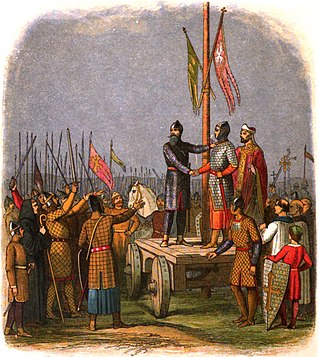
Walter Espec was a prominent military and judicial figure of the reign of Henry I of England.
Ælfgifu of York was the first wife of Æthelred the Unready, King of the English; as such, she was Queen of the English from their marriage in the 980s until her death in 1002. They had many children together, including Edmund Ironside. It is most probable that Ælfgifu was a daughter of Thored, Earl of southern Northumbria and his wife, Hilda.

The Liber Eliensis is a 12th-century English chronicle and history, written in Latin. Composed in three books, it was written at Ely Abbey on the island of Ely in the fenlands of eastern Cambridgeshire. Ely Abbey became the cathedral of a newly formed bishopric in 1109. Traditionally the author of the anonymous work has been given as Richard or Thomas, two monks at Ely, one of whom, Richard, has been identified with an official of the monastery, but some historians hold that neither Richard nor Thomas was the author.
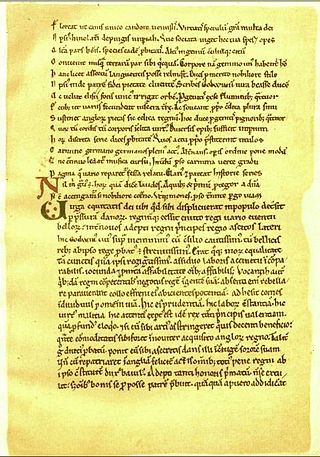
The Vita Ædwardi Regis qui apud Westmonasterium Requiescit or simply Vita Ædwardi Regis is a Latin biography of King Edward the Confessor completed by an anonymous author c. 1067 and suspected of having been commissioned by Queen Edith, Edward's wife. It survives in one manuscript, dated c. 1100, now in the British Library. The author is unknown, but was a servant of the queen and probably a Fleming. The most likely candidates are Goscelin and Folcard, monks of St Bertin Abbey in St Omer.
The Vita Sancti Niniani or simply Vita Niniani is a Latin language Christian hagiography written in northern England in the mid-12th century. Using two earlier Anglo-Latin sources, it was written by Ailred of Rievaulx seemingly at the request of a Bishop of Galloway. It is loosely based on the career of the early British churchman Uinniau or Finnian, whose name through textual misreadings was rendered "Ninian" by high medieval English and Anglo-Norman writers, subsequently producing a distinct cult. Saint Ninian was thus an "unhistorical doppelganger" of someone else. The Vita tells "Ninian's" life-story, and relates ten miracles, six during the saint's lifetime and four posthumous.
De Sanctimoniali de Wattun or On the Nun of Watton is a 12th-century miracle story, describing events which took place in Yorkshire in the mid-12th century at the nunnery of Watton, East Riding of Yorkshire. It is also called A Certain Wonderful Miracle.
The Historia Ecclesie Abbendonensis or History of the Church of Abingdon was a medieval chronicle written at Abingdon Abbey in England in the 12th century. The Abbey was historically in the county of Berkshire, but since 1974 has been in the county of Oxfordshire.
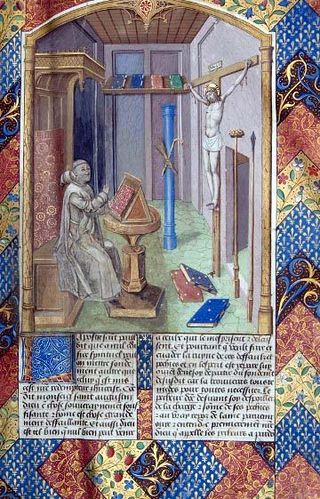
The Vita Christi, also known as the Speculum vitae Christi is the principal work of Ludolph of Saxony, completed in 1374.
Chrysogonus Waddell was an American Roman Catholic convert and theologian. A Trappist monk of the Abbey of Gethsemani, Kentucky, he was an accomplished organist, liturgist, historian, and a scholar of chant and Cistercian liturgy.
John R. Sommerfeldt was an American university professor, medievalist and scholar of Cistercian Studies.
References
- Bliese, John. “The Battle Rhetoric of Aelred of Rievaulx.” Haskins Society Journal1 (1989): 99–107.
- Burton, Pierre-André. Aelred de Rievaulx (1110–1167): Essai de Biographie Existentielle et Spirituelle. Paris: Les Éditions du Cerf, 2010.
- Burton, Pierre-André. “Le Récit de La Bataille de l’Étendard par Aelred de Rievaulx. Présentation et Traduction.” Cîteaux58 (2007): 7–41.
- Dutton, Marsha L., ed. (1986), Aelred of Rievaulx: The Historical Works, Cistercian Fathers Series: Number Fifty-Six, Freeland, Patricia (translator) (3rd ed.), Kalamazoo, Michigan: Cistercian Publications, ISBN 0-87907-288-1
- An English translation of this text is on pp. 245—69
- Freeman, Elizabeth. “Aelred of Rievaulx’s De Bello Standardii.: Cistercian Historiography and the Creation of Community Memories.” Cîteaux 49.1–2 (1998): 5–28.
- Freeman, Elizabeth. “The Many Functions of Cistercian Histories Using Aelred of Rievaulx’s Relatio de Standardo as a Case Study.” In The Medieval Chronicle: Proceedings of the 1st International Conference on the Medieval Chronicle. Edited by Erik Kooper. Amsterdam and Atlanta: Rodopi, 1999. 124–132.
- Freeman, Elizabeth. Narratives of a New Order: Cistercian Historical Writing in England, 1150–1220. Turnhout, Belgium: Brepols Publishers, 2002.
- Gransden, Antonia (1997), Historical Writing in England, vol. 1, c. 550—c.1307, London: Routledge, ISBN 0-415-15124-4
- Howlett, Richard (ed.). "Relatio de Standardo", in Chronicles of the reigns of Stephen, Henry II and Richard I, 3, Rerum Britannicarum medii aevi scriptores, 82, (1886).
- For the Latin text, see pp. 179-99
- Thomas, Hugh M. (2003), English and the Normans: Ethnic Hostility, Assimilation, and Identity 1066-c.1220, Oxford: Oxford University Press, ISBN 0-19-925123-1